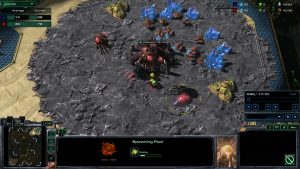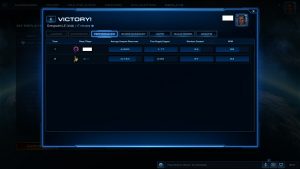I have decided to focus on Starcraft II for my skill. As a gamer, I have a wide experience in the subject of video gaming, but very little when it comes to a genre that Starcraft II (SC2) is part of: Real time strategy (RTS). My focuses have always been in the First Person Shooter (FPS), Multiplayer Online Battle Arena (MOBA), and Role Playing Game (RPG) genres. I briefly followed the professional Starcraft eSports scene many years ago, but aside from that, I have very little practical playing experience. Furthermore, I have chosen SC2 because of the many metrics that are collected by the game, which could be used to measure skill acquisition, making it very intuitive for this project.
For those unfamiliar with the game or genre, in SC2 and other RTS games, the premise is traditionally that you start on a map with an overhead view. From there, you have a small starting “base”, which contains a core building and a few worker units. The worker units can gather resources, which in turn let you build other units and buildings, unlocking new things as the game progresses. You use these resources to construct more workers (to develop an economy) and eventually build an army, which you use to attempt to destroy your opponent’s forces. A player wins when all of their opponents structures have been destroyed, or that opponent surrenders. Below you can find a screenshot of the user interface.

Now we need to decide upon some metrics to measure skill within this game. SC2 has built into it a replay system, which allows you to go back and see any game you have previously played. This is excellent for our purposes, as we can always look backwards to check our progress. Furthermore, the game collects several metrics for us which are traditionally used by the SC2 community to measure skill. Below you’ll find a screenshot of the post game score sheet, which contains some of the performance metrics:

These metrics are as follows (All numbers are from my first game versus the A.I.):
Average Unspent Resources: The average number of unspent Minerals & Vespene Gas throughout the course of the match. This is an important metric to many players because any unspent resources are dead weight. They’re potential buildings and units that could have been created and leveraged against your opponent, but instead were sitting idle. There is no “interest” in SC2. There is no benefit to banking resources, unless you are waiting to unlock a new unit type. Very rarely do you want to hold onto a large amount of resources, so a large unspent resource number indicates poor skill or planning. Mine here was 4,595 compared to the “easy” A.I.’s 3,745, marking my play as grossly inefficient and very poor overall.
Time Supply Capped: There is a resource known as “Supply” in SC2, that is, how many units you can have at any one time. You can increase supply by building certain structures or units, up to a maximum of 200. Being “Supply Capped” refers to having hit your maximum supply, at which time you should traditionally have been building more supply structures/units so that you can continue to grow your army. The game records, in number of seconds, how long this has happened to you over the course of a match. A higher time supply capped again indicates poor planning or execution, and overall poorer skill. Once again I do very poorly, having spent 1 minute and 17 seconds supply capped, compared to the A.I.’s 22 seconds.
Workers Created: This is how many worker (or economy) units you have created throughout a match. Generally, a higher number indicates a stronger economy and greater skill. There are times when creating more workers might not be the best idea, however, so I do not fully understand the correlation between worker creation and perceived skill. Nonetheless, I created 54 workers to the A.I.’s 87.
APM: Another popular metric of overall skill is APM, or Actions Per Minute. This is essentially how many actions you’ve ordered to your units, averaged over the course of the entire match. It is seen as a measure of speed and skill, with better players traditionally having higher APMs. My APM here is 58, and the A.I.’s is 83. This is abysmal for most people in the SC2 community. Professional players reach APM’s typically exceeding 300, and sometimes even 400 or more. To learn a little bit more about APM and how it relates to Starcraft, consider this clip from the documentary “The Hax Life.”
These are just the basic metrics considered by the game itself. We can also explore some other options such as Win/Loss, Match Length, and so on. More skilled players often breakdown their games into “build orders”, which are sequences of when to build what object. For example, an ideal goal might be to have a certain structure built by the 2 minute mark of a match, and so on. The game itself provides a build order summary of your match so that you can easily compare your real world performance versus ideal performance, and this could be used as a metric in our analysis.
Lastly, I will talk about the process. Thus far, I have only completed a single game of SC2 against the A.I. The game itself tells you to play a few matches against A.I. so that it can calibrate your skill level. Once that is done, we will move forward and continue training against the A.I. until the basics of the game are known, and our performance metrics have improved. At that time, it might become prudent to move on to real players. If we do so, another performance metric can be used, which is MMR or Match Making Rating. This is an estimation of your skill, much like ELO from chess. However, the algorithm is proprietary to Blizzard (SC2’s developer) and we do not know an exact number at any given point. We have estimations based on which competitive league you are placed in, after you calibrate. Leagues are separated into the following categories, from lowest skill to highest: Bronze, Silver, Gold, Platinum, Diamond, Master, Grandmaster. Additionally, each league has three divisions: 3, 2, and 1, with 1 being the highest skilled division within a league. The process for advancement is fairly simple. As you play matches, and win them, your MMR goes up. As it goes up, you will rise through divisions. When you have reached division 1, if you win enough games, you will get to challenge someone from division 3 of the next league up. If you win enough of these “qualifying matches”, you advance to that league and start again at the bottom of division 3.
That’s all for now. I will update after I have calibrated and know how we are moving forward.
